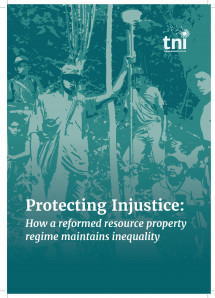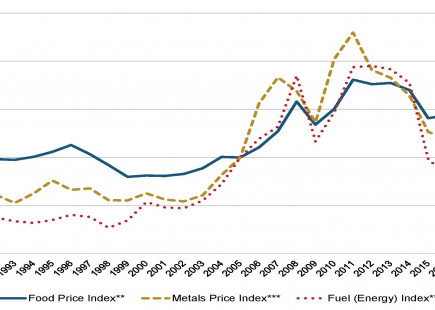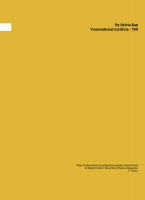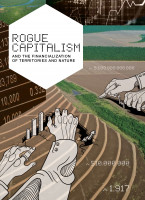Protecting Injustice How a reformed resource property regime maintains inequality
Temas
The way that ownership and control of land and resources is managed and understood is changing globally, even as changes in financial markets and the climate catastrophe are putting increasing pressure on land and land-based resources. The changes taking place can appear progressive and positive - for example, more and more governments and other actors now recognize collective ownership of land. But the way change is taking place is less transformative than it looks and is in fact creating new opportunities for corporations to profit from land and natural resources, to the detriment of local communities. Our latest report explores how and why this change is taking place, what actors are helping to shape our understanding and management of land and natural resources, and who stands to benefit and to lose from these changes.

Autores

* Only January to June 2017 average (latest data available on 17/01/2019)
** Includes cereals, vegetable oils, meat, seafood, sugar, bananas, and oranges price indices
*** Includes copper, aluminium, iron ore, tin, nickel, zinc, lead, and uranium price indices
**** Includes crude oil (petroleum), natural gas, and coal price indices
Source: Author elaboration with data from IMF (2018).
Download the full paper here.
The research and writing for this paper was completed before the 2020 Coronavirus crisis, which is therefore not treated here. However many of the dynamics noted and explored here have shaped global responses to the crisis, and will continue to have major and ongoing impacts throughout the pandemic crisis and beyond.
In examining the 2008 crises, two effects are especially noticeable: the emergence of new “transition” discourses, and the higher, but more volatile, prices of commodities. A variety of transition proposals for addressing the crises have been put forward by state, corporate, and social actors and have persisted beyond the 2010s. These include proposals to take steps towards green energy production, feeding a growing world population, addressing climate change and biodiversity loss and – although these have gained much less traction – regulating global financial systems. Regarding commodity prices, figure 1 shows the sharp spike of commodity prices during the crises. Although these collapsed around 2014, prices for especially metals and food remain significantly higher than before 2008.
These two booms –in transition discourses and commodity prices– have been interacting to produce a new global resource rush. On one hand, there has been a global, but uneven, resurgence of natural resource extractivism. At the same time, there has been an increasing commodification of nature, facilitated by the framing of natural landscapes, ecosystems and processes in terms of “environmental services” - the diverse benefits which humans derive from ecosystems. Enhanced and/or new forms of resource extraction and enclosures of nature are being presented as climate change mitigation and adaptation strategies, and transition discourses are opening up new frontiers for accumulation.
This new global resource rush entails important and far-reaching changes in how access to resources is controlled, and by whom. It is transforming economic, socio-ecological, and cultural relations around the world. Different actors have responded to these trends in different ways, and a clear understanding of the positioning of different actors is important for understanding the possible outcomes and beneficiaries of different interventions. In 2013, Borras et al. identified ‘three competing political tendencies among state and non-state actors with regard to global governance of land grabbing’: regulating to facilitate land grabbing, to roll it back, or mitigate harms associated with grabbing. Building on this schema, three main competing political standpoints can be identified with regard to the current global resource rush and the changes in resource control associated with it. According to their political approaches, actors can be characterised as supporters, challengers or accommodators of the new global resource rush.
Supporters actively promote the current changes in resource control. As the Director of the Agricultural and Rural Development Department of the World Bank argues
[W]hen done right, larger-scale farming can provide opportunities for poor countries with large agricultural sectors and ample endowments of land. To make the most of these opportunities, however, countries will need to better secure local land rights and improve land governance. Adopting an open and proactive approach to dealing with investors is also needed to ensure that investment contributes to broader development objectives’
Pushing in the opposite direction, challengers turn their objections to the global resource rush into active resistance, and struggle for a just, transformative project. For instance, for the human rights organisation FIAN, ‘the human right to land aims at social and environmental justice, transforming power relations and addressing social and economic inequalities’. At the Transnational Institute, Borras and Franco link FIAN’s understanding of the right to land and other resources to the food sovereignty alternative popularised by transnational agrarian movement La Via Campesina. As a result, they come up with the ‘land sovereignty’ alternative, or ‘the right of working peoples to have effective access to, use of, and control over land and the benefits of its use and occupation, where land is understood as resource, territory, and landscape’.
However, at the global scale many, perhaps most, actors take an accommodative political standpoint,regardless of their disapproval of or sympathy with the political agenda of the resource rush supporters or challengers. While they may favour one or the other extreme, they seek to pragmatically adapt their actions and claims to what they see as the current political reality. The political agency of these actors, characterised here as accommodators, should not be understated. They play an active political role through their efforts to mould themselves, or those who they claim to represent, to better fit their changing circumstances.
Ultimately, the complex and messy politics behind the current global resource rush are reshaping the understandings, institutions and governance of resource property which became mainstream with the onset of neoliberal globalisation. In fact, the reform examined here is the outcome of the consolidation, deepening and/or mainstreaming of a series of resource property dynamics which took place under neoliberalism, from the 1970s to the mid-2000s. For those seeking an emancipatory and transformative change in how resources are owned, managed, accessed and controlled in the future, a more comprehensive and relational understanding of the changes which are occurring, and the implications for and responses by different actors, is critical. This report will argue that, while the reform in question is sometimes represented as part of a progressive shift that could improve the lives of resource-dependent ‘working people,’8 its potential has been overstated and it is more likely to reinforce existing inequalities in wealth and power, unless it is more strongly linked to a broader transformative project.
Reforming the Neoliberal Resource Property Regime
The current resource rush is not only reshaping who has access to and control over resources. It is also actively transforming the way in which property and rights to resources are governed and understood. The overarching legal, technical, moral, and political framework which informs the understanding of property rights in relation to natural resources is referred to here as ‘the resource property regime’. In the broadest sense, a regime is a set of social institutions and practices which link together actors in certain relatively stable patterns. The resource property regime, specifically, refers to the actors and institutions that shape how natural resources are used, governed, and understood.
Since 2008, a range of (activist) scholars and affected communities have developed analyses of agrarian and environmental change in the context of the global crises from 2008 onwards, and the politics behind them. But the ways in which the dominant resource property regime and the global resource rush mutually shape each other have received less attention, or have been restricted to technical analyses of resource property rights. However, who has the abilities and power to effectively control the planet’s natural resources, to what extent, how, and for what purposes, are not just technical matters. Rather, these are highly political questions involving power relations among individuals and groups.
Resource property relations play a critical role in shaping how resources are used, who benefits, and who pays the price or bears the burden of cultural, social, or ecological destruction often associated with resource extraction, especially for commercial purposes. Hence, the resource property regime can be understood from a variety of different standpoints. From the economic perspective, resource property relations are rent distribution relations (for instance, who is entitled to charge rent for the use of land or to receive payments for ecosystem services). Ecologically, resource property relations determine who has the ability to control access to so-called environmental resources and services, and to transfer the burden of waste and contamination to others. Culturally, resource property relations are ideologically rooted, expressing ‘whose norms and meaning- making practices define the terms and values that regulate social life’. As a social institution, property expresses existing enforceable claims [i.e. “legal” rights] to ‘some use or benefit of something, whether it is a right to a share in some common resource or an individual right in some particular things’. Different individuals and groups expect the institution of property to serve different purposes. These different purposes vary along class, ethnic, gender, religious, and other socio-cultural attributes, which also overlap and intersect.
The following three purposes of natural resource property stand out in the world today: i) as resources,meaning a natural (i.e. not manufactured) and immobile means for producing goods; ii) as external nature, that is, as non-human sources and deposits of nature’s flows of energy and materials, and/or; iii) as territory, referring to ‘the relationship between land and identity, and the existence of (or aspirations for) political authority over land’. In pursuing different purposes of resource property, different actors contest or defend different dimensions of a property rights regime.
For the purpose of understanding resource property regimes in a comprehensive and relational fashion, six key dimensions can be identified: the object, subject, form, enforcing authority, policy structure and justification of or for property. Put another way, six distinct questions inform property relations among individuals and groups, as well as among humans and non-human nature, and all are currently being transformed. These six questions are:
1. What is property?
Relatedly, what is the object of property? In general, objects of property include consumables (e.g. a carrot) as well as means of production (e.g. tools or machinery). In the current regime, the object of property might also include other forms of ‘commodified nature’ (e.g. seeds or ocean spaces containing fish), as well as information, knowledge and its applications (i.e. technology). What can be an object of property shifts over time and is not a product of the innate qualities of the thing.
2. Who can own property?
(i.e. the subject of property) This might include a question of whether certain categories of person can own property (e.g. women), but can also extend to the question of whether property can only be owned by individuals. Can groups, communities, families, or corporations also own property?
3 What form does property take?
Forms of property today include open access, state property, common private property and individual private property.16 The first three forms are sometimes all referred to as ‘the commons,’ conflating these potentially different phenomena. In fact, these three forms are distinct from each other. Open access is property ‘belonging to no-one’ - the atmosphere, for example. Common private property, on the other hand, involves the rights of the co-owners to benefit from – and not be excluded from – co-owned property (e.g. specific people may have rights to hunt or gather firewood in a commonly owned forest). Finally, state property, like the private property of non-natural persons (e.g. a corporation or NGO), entails ‘a corporate right to exclude,’ where the owner can set conditions regarding who can access the property and why.
4 Who controls the property regime?
Where is the authority to enforce property rights, and sanction changes in the property regime, located (i.e. in state or non-state actors)?
5 How are policies relating to property structured?
Is property governed primarily by state law, or by community conventions and/or traditions? This refers to the specific mechanisms through which property relations are governed, including through conventional, customary or statutory policy and regulation, and;
6 Why is a property regime legitimate?
This refers to the ideological and moral justifications behind a particular property rights regime. On what moral grounds do the people, communities, or institutions who control resource property justify that control?
This report explores the broad directions of change in the dominant resource property regime today, following the global resource rush under convergent crises. It details the drivers, protagonists, and political implications of this change. While examples from the (sub-)national scales are employed, the focus is on the transnational and international levels of governance of land, fisheries, forests, seeds, underground and seabed resources (e.g. hydrocarbons and minerals), natural processes and systems often conceptualised as environmental services (e.g. carbon sinks, natural water filtration by forest ecosystems), and the information and knowledges that enable individuals and groups to benefit from a resource.
This reform effort was sparked by the failure of the post-World War II multilateral governance system, and of neoliberal capitalism, to respond to the convergent global crises, and to manage their negative impacts on resource-dependent working people. In brief, this report argues that an alliance, made up of visionary global resource rush supporters and influential accommodators, have taken firm steps to reform the natural resource property regime which was dominant since the 1970s, under neoliberalism. Despite its far reaching social and ecological implications, the rationale behind this alliance is simple. Trailblazing investors in a supportive political stance seek to reduce resource tenure risks at the grassroots level and reputational risks worldwide. Influential NGOs in an accommodative political stance seize this as a political opportunity, trying to get the most out of the current wave of land and other resource deals for local communities. Specifically, large watchdog NGOs in an accommodative stance use the media “stick” to name and shame bad investors,18 and reward good investors with sustainability seals and positive assessments of corporate performance through the pro-social branding “carrot”.
This reform alliance works through highly influential multistakeholder initiatives and involves a series of distinct shifts in each of the six dimensions of the resource property regime. The resulting change is more than the sum of its parts. This synergistic outcome is called here the resource property reform under convergent global crises. The reform essentially involves: i) consolidating and advancing the boundaries of the commodification of nature, including through digitalisation and financialisation, thereby creating new objects of property; ii) advancing the legal personhood of charities and corporations as subjects of resource property rights, including making the case for corporations as both duty bearers and rights holders in relation to human rights; iii) mainstreaming the communal form of private resource property, while also providing new ways for actors to profit from resources that they do not own; iv & v) expanding the non-binding, but state-sanctioned, voluntary institutional and regulatory policy structure that gives more freedom for self-governance by the private sector as a mode of creating and enforcing resource governance rules, and; vi) justifying all of these dynamics as efficient, pragmatic and rightful cornerstones in the transition toward global sustainability and well-being.
Thus, the resource property reform under convergent global crises is transforming the dominant resource property regime, including through changes in the object, subject, dominant form, enforcing authority, policy structure and justification of natural resource property. These transformations will have profound effects on the lives of resource-dependent working people, on the profits of those who stand to benefit from the emerging regime, and on the health of planet Earth.


